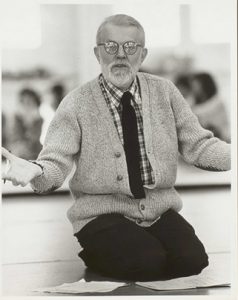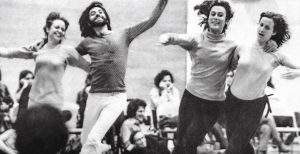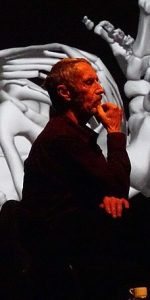The Postmodern movement emerged during the early 1960s and reflected the revolutionary mood of the times. Postmodern choreographers began to question the reasons for dance-making, who could dance (can untrained people be performers?), what could be used as music (can silence be music?), and experimented with where dance could occur. Performances began featuring ordinary movements with non-dancers and were done in non-traditional settings such as art galleries, churches, outdoor settings, and even on the sides of buildings. Another feature that emerged in the postmodern period was the rise of dance collectives with no one named choreographer. Judson Dance Theater and Grand Union are great examples of this trend.

Robert Dunn was a musician that played piano for Merce Cunningham’s classes. Dunn was drawn to the radical principles of John Cage and attended his classes on composition. Eventually, he would use the concepts learned from Cage and apply them to dance in choreography workshops attended by Yvonne Rainer, Steve Paxton, and Tricia Brown, among others. Dunn encouraged them to be risk-takers by encouraging ongoing experimentation.
Dunn’s dance composition classes found residency at Judson Memorial Church and adopted the name of Judson Dance Theater for their dance collective. The Judson Dance Theater dancers met weekly and were given assignments, performed their choreographic works, and critiqued each other. The artists mainly used improvisation as the source for generating movement. The Judson Dance Theater eventually disbanded, and the Grand Union emerged, created by several of the Judson Dance Theater dancers and new members.

The Grand Union was a collaborative effort with all dancers contributing to the artistic process of the group. They experimented with multimedia performance art and improvisation. Their creative research encouraged artists to expand their definitions of dance to include pedestrian movement (ex: walking and running) and task-oriented movement (ex: dancers must maintain physical contact throughout the entire dance). These allowed for the participation of both trained and untrained dancers to perform. In addition, the artists sought out alternative spaces for dancing, such as warehouses and lofts. Choreographers made statements with their works rather than storytelling.
Yvonne Rainer studied with Martha Graham and Merce Cunningham. Robert Dunn’s choreography workshop influenced her work as a choreographer. She was interested in the use of repetition, games, tasks, and partnering, which would become common choreographic practices employed in dance-making.

Watch This
Rainer’s Trio A, a solo dance featuring pedestrian movement.
Steve Paxton studied and performed with Limón and Cunningham. He was inspired by the improvisation techniques explored during the Judson Dance Theater and Grand Union collaborations. Paxton developed “contact improvisation,” which has principles based on weight-sharing, touch, and movement awareness” paired with pedestrian movement.

Watch This
An example of contact improvisation. The dancers maintain a point of contact and trade-off weight sharing.
Trisha Brown studied with several notable teachers, including Merce Cunningham. In the early 1970s, she founded the Trisha Brown Company, engaging in “site-specific” works. These are performance spaces outside the conventional theater, such as dances on rooftops. She also explored avant-garde and postmodernist ideas to experiment with pure movement and repetitive gestures in dance.

Watch This
Brown’s Man Walking Down the Side of a Building.